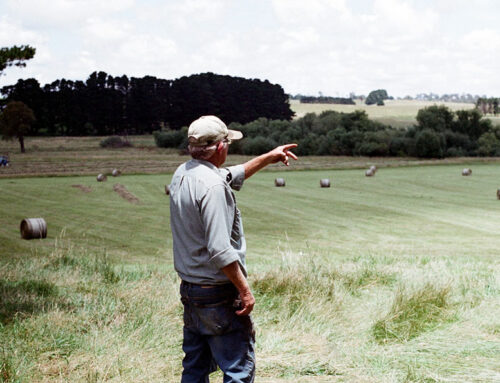The future looks bright in Rocksprings, Texas — Mohair Capital of the United States.
Joe Holley of the Houston Chronicle reports that the small Hill Country town remains deeply attached to its signature industry. “The Rocksprings High School Angoras play in Angora Stadium; mascot Rocko, the fighting Angora billy, watches from the sidelines. The local newspaper, the Rocksprings Record and Texas Mohair Weekly, is in its 128th year, serving an area that produces about 90 percent of the nation’s mohair.”
But about 25 years ago, the forecast looked bleak. The Clinton administration had put mohair’s $100 million a year subsidy on the chopping block. Congressmen from both sides of the aisle openly mocked the program as a waste of money. The Los Angeles Times ran an article titled As Subsidies Near End, Goat Ranchers Fear Extinction, and the Washington Post reported, “Without this program, Rocksprings would just roll up into a ball of dust and blow away.”
Except they didn’t. The mohair industry didn’t die. While a drastically reduced version of the subsidy still exists, mohair farmers received $0 in federal subsidies for eight of the last ten fiscal years. Holley says the Angora goats of Rocksprings are “… still the backbone of the economy.” What changed? And why was there a mohair subsidy in the first place?
The US mohair market’s transformation from a symbol of waste into a healthy, independent industry is both a success story and a model for the future of American agriculture.
In the beginning, the mohair subsidy was as a perfectly reasonable idea. It was created in 1954 when mohair was included on the Pentagon’s critical resource list. At the time, mohair was one of the fabrics used to make military uniforms, and the Pentagon wanted to ensure that the mohair market was large enough to ramp-up to wartime production levels, if needed.
In 1960, synthetics such as Darcon replaced mohair. So why didn’t Congress end the subsidy? Welcome to the world of special interests groups. The phenomenon was famously documented by political theorist Mancur Olsen in The Logic of Collective Action. He argued that it’s actually harder for a large society to create policies that benefit the common good and easier for small groups of people to create policies that harm the common good for their own benefit. The high cost of organizing large groups, the free-rider problem, and higher social familiarity among small groups, “…leads to the result that smaller groups (or what some would call “Special Interest Groups”) are able to have policies enacted that hurt the country as a whole.”
The mohair lobby successfully continued the unnecessary subsidy for another 43 years — then Jonathan Rauch came along. While Olsen broadly theorized about collective failures, Rauch took this basic framework and shone a spotlight wasteful federal programs, making mohair the poster child. His seminal book Demosclerosis skewered the federal budget, calling it “a giant frozen mass of ossified programs trapped in a perpetual cash crunch” which rendered the government unable adapt to change. He argued that a small, uninteresting program like the mohair subsidy was harder to kill because the beneficiaries vigorously lobby while ordinary taxpayer doesn’t take notice. And while it sounds easy enough to broadly attack a category of ‘wasteful special interest spending’, naming names will get your average Congressman in trouble. They’ve made a new enemy of whatever constituency receives the subsidy and have gained no allies.
His book caught the interest of government spending watchdogs, and the mohair subsidy became a national embarrassment. The New York Times ran an article titled The Mohair Toilet Seat. Rocksprings ranchers were all the sudden standing in front of national reporters, sheepishly explaining why a rugged frontier town relied so heavily on Uncle Sam (pun ABSOLUTELY intended).
In 1993 the subsidy was killed, but the mohair lobby successful secured a much smaller version three years later. But even in it’s reduced state, mohair was still a congressional punching bag. In 2010, Reps Jason Chaffetz and Anthony Weiner staged a press conference starring two Angora goats to criticize the $750,000 (that’s thousand, not million) mohair farmers received that year. (Fun fact: One of the goats, named Lancelot, rammed Weiner’s thumb, managing to draw blood. It remains the second-most embarrassing political scandal of his career).
While the bloated mohair subsidies through 1993 deserve their mockery, I don’t believe the same criticism was warranted in 2010 or today. In fact, the current program is a model for how American agriculture can move away from the multibillion dollar annual subsidies it relies on.
Unlike mohair, staple crops like corn, wheat, and cotton are still vitally important to our national well-being, so the associated subsidies cannot be written off as mere frivolous waste. The modern system of agriculture subsidies — a subject beautifully and thoroughly explored in the 2007 documentary King Corn — can be traced back to Earl Butz, US Secretary of Agriculture from 1971–76. He changed federal subsidies from a system that reduces crop growing (i.e. paying farmers not to grow), into a system designed for maximum production. Butz credits his system with encouraging the industrial efficiencies that have made food much cheaper today than in generations past. Food went from costing over a third of a typical family’s budget in the 1930s to less than a tenth today.
However, critics have plenty to say about Butz’s policy sea-change. His relentless drive for efficiency drove all but the largest corporate farmers to ruin. And by encouraging large-scale monocropping, he created the unintended consequences of environmental harm and a poorer American diet, especially by creating cheap and plentiful high fructose corn syrup. And economists argue that subsidies in general create market inefficiencies, such as growing crops in a suboptimal climate, that would not exist in a competitive market. Then there’s the literal cost — $46 billion in 2020 alone.
I think it’s fair to say that half a century of agricultural industrialization isn’t going anywhere with or without subsidies. If we got rid of all farm subsidies tomorrow, food prices would only rise by 2%. Is a future without dependence on massive federal subsidies possible for US agriculture? It was certainly possible for mohair, despite serious doubts in the 90s.
I spoke with Joshua Sewell at Taxpayers for Common Sense, a nonprofit, nonpartisan budget watchdog group. I asked him if the transformation of the mohair market can be a model for the rest of agriculture.
“I think it is possible,” he says. “It’s important to look back at these things — where folks fear that a massive change in policy is going to render the rivers red and the seas boiling — and when it doesn’t happen, then I think we should figure out why not and that can be a great lesson learned.” He argues that politicians, commodity groups, and sometimes even farmers themselves tend to “…underestimate the abilities of American farmers.” He believes that they’re capable of doing the difficult work of adjusting to market realities in ways that are profitable, but says “The truth is you’re not going to do that unless you have to. So some folks find it easier and frankly some of us in Washington can make a lot of money creating programs and lobbying to maintain programs that keep the status quo.”
Today’s mohair subsidy was created in 2002 as part of a broader agricultural bill that created the Nonrecourse Marketing Assistance Loan. These loans allow farmers to apply for below-market interest rate loans with their crop as collateral. The money helps farmers endure a period of low crop prices, typically around harvest time, and allows them to wait to sell until the price rises.
The new program isn’t perfect. Sewell notes that certain commodity groups like cotton and peanuts, “…have turned the marketing loan program away from being a really helpful federal support into more of a guarantee payment program or one that artificially produces a higher price than the market can sustain.” And if prices don’t rise enough, the farmers should theoretically surrender their crop to the government. But since the government has zero interest in storing and reselling crops, Sewell says the government will typical float the farmers more cash till prices finally do rise.
But for mohair, the largess of the old subsidies isn’t particularly missed. The American Sheep Industry Association, who also saw their wool subsidies cut in the same period, wrote a piece reflecting on the industry 25 years later. “But I think we’re stronger today because we don’t have it. Personally, I think that any part of agriculture that can be weaned off of these types of programs — other than necessary disaster programs — is better off in the long run…But now, there’s a whole new generation of sheep producers who don’t even remember it.”
From their low point as a federal boondoggle, the Angora goats of Rocksprings have risen up and now stand tall, proudly unsullied by bloated federal subsidies. May this fluffy symbol of redemption be a beacon of hope for us all!











Get Social